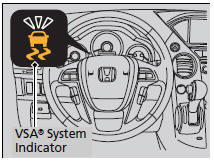VSA® (Vehicle Stability Assist), aka ESC (Electronic Stability Control), System
VSA® helps to stabilize the vehicle during cornering if the vehicle turns more or less than what was intended. It also assists in maintaining traction on slippery surfaces. It does so by regulating engine output and selectively applying the brakes.
VSA® Operation
When VSA® activates, you may notice that the engine does not respond to the accelerator. You may also notice some noise from the hydraulic system. You will also see the indicator blink.

VSA® (Vehicle Stability Assist), aka ESC (Electronic Stability Control), System
The VSA® may not function properly if tire type and size are mixed. Make sure to use the same size and type of tire, and the air pressures as specified. When the VSA® indicator comes on and stays on while driving, there may be a problem with the system. While this may not interfere with normal driving, have your vehicle checked by a dealer immediately. VSA® cannot enhance stability in all driving situations and does not control the entire braking system. You still need to drive and corner at speeds appropriate for the conditions and always leave a sufficient margin of safety. The main function of the VSA® system is generally known as Electronic Stability Control (ESC). The system also includes a traction control function.
VSA® On and Off
This button is on the driver side control panel. To turn the VSA® system on and off, press and hold it until you hear a beep.
VSA® will stop and the indicator will come on.
To turn it on again, press the  (VSA® OFF) button until you hear a beep.
(VSA® OFF) button until you hear a beep.
VSA® is turned on every time you start the engine, even if you turned it off the last time you drove the vehicle.

VSA® (Vehicle Stability Assist), aka ESC (Electronic Stability Control), System
Without VSA®, your vehicle will have normal braking and cornering ability, but
it will not have VSA® traction and stability enhancement. In certain unusual conditions
when your vehicle gets stuck in shallow mud or fresh snow, it may be easier to free
it with the VSA® temporarily switched off. When the VSA® system is off, the traction
control system is also off. You should only attempt to free your vehicle with the
VSA® off if you are not able to free it when the VSA® is on. Immediately after freeing
your vehicle, be sure to switch VSA® on again. We do not recommend driving your
vehicle with the VSA® and traction control systems switched off. If the low tire
pressure/TPMS, low tire pressure, or TPMS indicator comes on or blinks, the VSA®
system comes on automatically. In this case, you cannot turn the system off by pressing
the  button. You may hear a motor sound
coming from the engine compartment while system checks are being performed immediately
after starting the engine or while driving. This is normal.
button. You may hear a motor sound
coming from the engine compartment while system checks are being performed immediately
after starting the engine or while driving. This is normal.
See also:
Playing an iPod®
Connect the iPod® using your dock connector to the USB adapter cable, then press
the USB/AUX button.
How to Select a File from the iPod® Menu
1. Press to display the iPod® menu.
2.Rotate ...
Audio Antenna
Your vehicle is equipped with an antenna at the rear of the roof . Bef ore
using a ‘‘drive-through’’ car wash, remove the antenna by unscrewing it by hand.
This prevents the antenna f ro ...
Maintenance
This chapter discusses basic maintenance. ...






